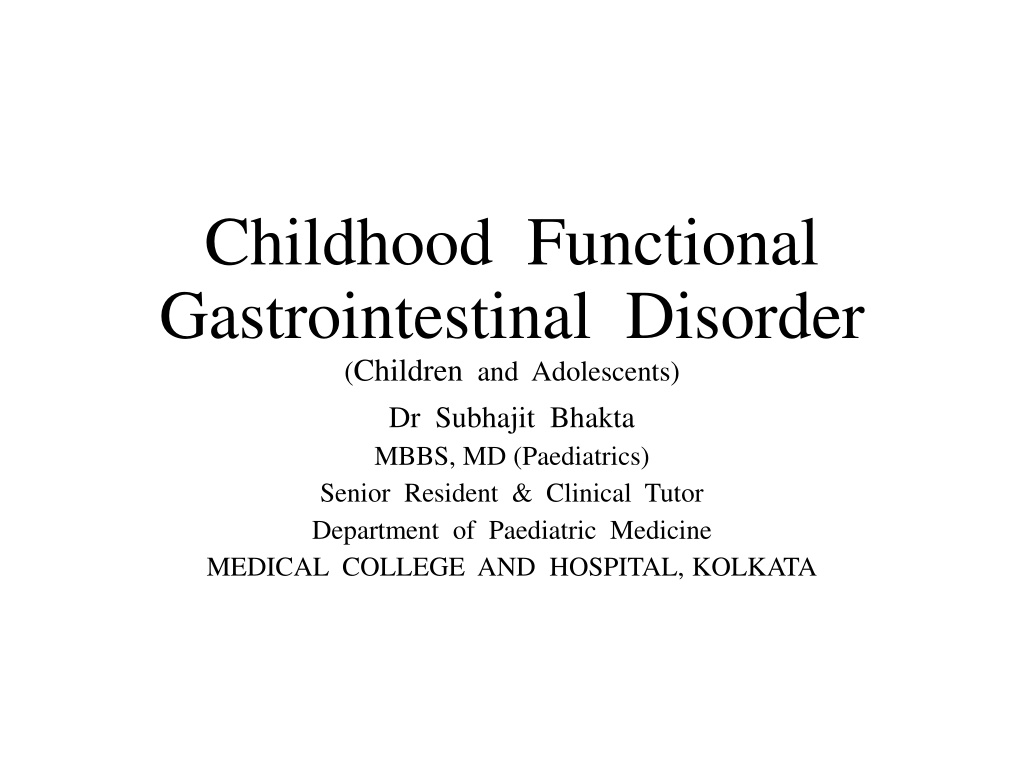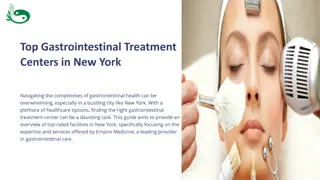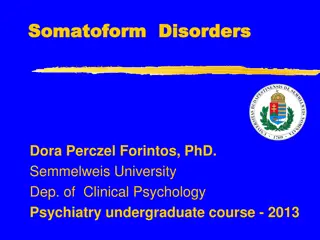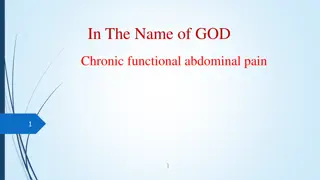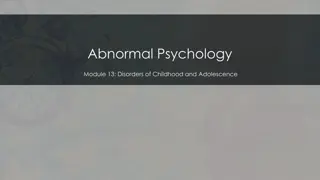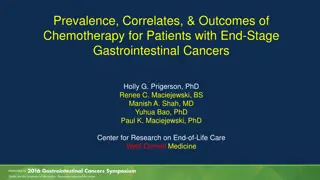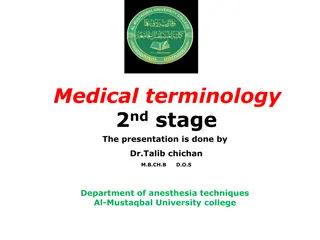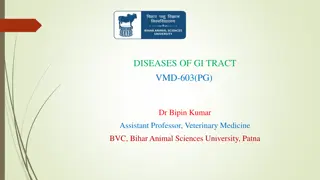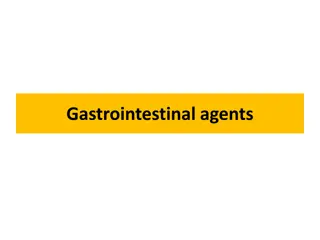Understanding Childhood Functional Gastrointestinal Disorders
Functional Gastrointestinal Disorders (FGIDs) in children and adolescents are characterized by chronic or recurring symptoms that cannot be fully explained by current structural or biochemical tests. These disorders emphasize the role of normal development in symptom presentation and the lack of evidence for organic disease. The Rome Foundation's criteria have evolved over the years, focusing on symptoms-based diagnosis and highlighting the co-existence of FGIDs with other medical conditions. Different FGIDs include nausea and vomiting disorders, functional abdominal pain disorders, and functional defecation disorders. This overview sheds light on the history, changes in diagnostic criteria, and classification of FGIDs in pediatric patients.
Download Presentation

Please find below an Image/Link to download the presentation.
The content on the website is provided AS IS for your information and personal use only. It may not be sold, licensed, or shared on other websites without obtaining consent from the author. Download presentation by click this link. If you encounter any issues during the download, it is possible that the publisher has removed the file from their server.
E N D
Presentation Transcript
Childhood Functional Gastrointestinal Disorder (Children and Adolescents) Dr Subhajit Bhakta MBBS, MD (Paediatrics) Senior Resident & Clinical Tutor Department of Paediatric Medicine MEDICAL COLLEGE AND HOSPITAL, KOLKATA
OVERVIEW Functional gastrointestinal disorders (FGIDs) are conditions that include a combination of symptoms that are: Chronic or recurrent That are not explained entirely with current structural or biochemical investigations. Functional emphasizes that many of the symptoms accompany normal development and may be response to otherwise normal internal and external cues.
HISTORY In 1987, Professor Aldo Torsoli described various gastrointestinal disturbances that appeared to cluster together with significant prevalence, constituting disorders. From there on a consensus approach was felt necessary for defining such disorders for research and clinical management guidelines. >> ROME FOUNDATION AND ROME CRITERIA: 1990: ROME I ( focused mainly on adults) 1996: ROME II ( included Paediatrics patients also) 2006: ROME III 2016: ROME IV
ROME IV : What has changed? 1. Symptoms Based Diagnosis has taken precedence: Less reliance of extensive investigations. Emphasis on selective or no testing . 2. no evidence for organic disease in all definitions replaced by after appropriate medical evaluation the symptoms cannot be attributed to another medical condition. ( understanding the fact the FGIDs can co-exist with other medical condition having GI symptoms i.e. IBD
ROME IV : What has changed contd . 3. abdominal pain related functional gastrointestinal disorders has been changed to functional abdominal pain disorders : 4. The fact that the different FGIDs can occur together and overlap significantly. 5. The classification and diagnostic criteria is tweaked and modified : help both clinician and researchers.
Functional Gastrointestinal Disorders: Children and Adolescents H1. Functional nausea and vomiting disorders (changed term) H1a. Cyclic vomiting syndrome H1b. Functional nausea and functional vomiting H1c. Rumination syndrome H1d. Aerophagia H2. Functional abdominal pain disorders (changed term) H2a. Functional dyspepsia H2b. Irritable bowel syndrome H2c. Abdominal migraine H2d. Functional abdominal pain not otherwise specified (new term) H3. Functional defecation disorders H3a. Functional constipation H3b. Non-retentive fecal incontinence
H1b: Functional Nausea and functional Vomiting These are new definitions in ROME IV: H1b1. Functional Nausea Must include all of the following fulfilled for the last 2 months: 1) Bothersome nausea as the predominant symptom, occurring at least twice per week, and generally not related to meals. 2) Not consistently associated with vomiting. 3) another medical condition After appropriate evaluation, the nausea cannot be fully explained by
H1b: Functional Nausea and functional Vomiting cont H1b2. Functional Vomiting Must include all of the following for at least 2 months before diagnosis: On average, 1 or more episodes of vomiting per Week. 1) 2) Absence of self-induced vomiting or criteria for an eating disorder or rumination. 3) After appropriate evaluation, the vomiting cannot be fully explained by another medical condition.
H1b: Functional Nausea and functional Vomiting cont Insufficient pediatric data on the prevalence of isolated nausea, isolated vomiting, or a combination of both in the literature. They can occur in isolation or in combination. The absence of concomitant pain differentiate this clinical entity from functional dyspepsia . This usually presents with chronic but mild symptoms. Recurrent and severe pattern of vomiting should raise more severe organic/ metabolic causes. ( CNS, GI obstruction, Gastroparesis, Endocrinal disorders).
H1b: Functional Nausea and functional Vomiting cont Predominantly seen in children with Psychological issues i.e. Anxiety, Depression. Important observation being Experiencing nausea only in early morning with history of sleeping late at night. TREATMENT OF Functional Nausea and functional vomiting : With Psychological Comoribidity: Mental Health Intervention: CBT, Hypnotherapy. Intractable Symptoms : Cyproheptadine, may be helpful. Gastric Electrical Stimulus, may be helpful.
H1a: Cyclical Vomiting Syndrome Community Prevalence: 0.2 1.0 %. Median age of onset: 3.5-7 yrs( can occur in infants to adults). 46% by 3rd year of life. If abdominal pain and vomiting both are present, the predominant or more consistent symptom should be considered for the primary diagnosis. i.e. If the predominant feature is abdominal pain, then abdominal migraine should be considered rather than CVS. Higher likelihood of underlying neuro-metabolic diseases in children with early onset of symptoms. Metabolic testing should be carried out during vomiting episodes and before starting of IV fluids.
H1a: Cyclical Vomiting Syndrome cont H1a. Diagnostic Criteria for Cyclic Vomiting Syndrome Must include all of the following: 1. The occurrence of 2 or more periods of intense, unremitting nausea and paroxysmal vomiting, lasting hours to days within a 6-month period. 2. Episodes are stereotypical in each patient. 3. Episodes are separated by weeks to months with return to baseline health between episodes. 4. After appropriate medical evaluation, the symptoms cannot be attributed to another condition
H1a: Cyclical Vomiting Syndrome cont Importance on Stereotypic Presentation in each individuals. --- ------------- Pattern . In ROME III usual state of health was there instead of return to baseline health . usual state of health could have been misinterpreted as being asymptomatic between episodes. but the new phrase allowed the coexistence of mild GI symptoms at baseline, which is often seen in clinical settings.
H1a: Cyclical Vomiting Syndrome cont TREATMENT OF CVS; 1STLine: < 5 years: Cyproheptadine. > 5 years: Amitriptyline. 2ndLine: Propanolol prophylaxis (all ages) Adjunctive : Acupuncture, CBT, Co-enzyme Q10, L-Carnitine. Abortive therapy: Hospitalisation, Liberal IV fluids, Anti-emetics
H1c : Rumination Syndrome Occurs in all ages: Adolescent Girls are particularly vulnerable Seen as a Habit disorder . Almost always there is a trigger event: An intercurrent infectious process / Traumatic Psychosocial events. Association with Psychiatric morbidity : Depression, Anxiety, OCD,PTSD May be associated with other FGIDs. Effortless repetitive regurgitation, re-swallowing, and/or spitting within minutes of starting a meal define rumination.
H1c : Rumination Syndrome H1c. Diagnostic Criteria for Rumination Syndrome Must include all of the following: 1. Repeated regurgitation and rechewing or expulsion of food that: a.Begins soon after ingestion of a meal b. Does not occur during sleep 2. Not preceded by retching 3. After appropriate evaluation, the symptoms cannot be fully explained by another medical condition. An eating disorder must be ruled out Criteria fulfilled for at least 2 months before diagnosis.
H1c : Rumination Syndrome Adolescent Ruminition Syndrome term obsolete. Its not necessarily Painless as some discomfort/ bloating may be present. Not compulsory to rule out Gastro esophageal reflux before diagnosis. PATHOPHYSIOLOGY: Anatomical displacement of LES into thoracic cavity after increased intra gastric pressure/ intra abdominal pressure. Gastro-jejunal manometry suggest :simultaneous increase in pressure ( r waves) across multiple areas of the upper gut. These pressure waves are thought to be the result of the contraction of the skeletal abdominal muscles.
H1c : Rumination Syndrome DIFFERENTIALS: o Eating disorder ( Bulimia) must be excluded. o Gastroesophageal reflux, gastroparesis, achalasia etc. TREATMENT: o Management as habit disorder. o Novel inpatient inter-disciplinary approach (psychiatrist, ped gastro, nutritionist)
H1d : Aerophagia Fairly common in Paediatric Population ( Prevalence 4.5-7.5%). Particularly common in patients of Neuro Cognitive Disability Younger children Stress related/ Anxiety related, Older children Chewing gum, rapid drinking habit. Common symptoms : Belching, fullness, early satiety, flatus.
H1d : Aerophagia H1d. Diagnostic Criteria for Aerophagia. Must include all of the following: 1. Excessive air swallowing 2. Abdominal distention due to intraluminal air which increases during the day 3. Repetitive belching and/or increased flatus 4. After appropriate evaluation, the symptoms cannot be fully explained by another medical condition. Criteria must be fulfilled for at least 2 months before diagnosis
H1d : Aerophagia Clinical Evaluation: D/D to rule out : Gastroparesis, Pseudo Obstruction, Malabsorption (celiac , Disaccharidase def), bacterial overgrowth. Treatment: There are no controlled studies in children to guide therapy, largely supportive and may include behavioral therapy, psychotherapy, and benzodiazepines.
H2. Functional abdominal pain disorders
H2a: Functional Dyspepsia H2a. Diagnostic Criteria for Functional Dyspepsia; Must include 1 or more of the following bothersome symptoms at least 4 days per month: 1. Postprandial fullness 2. Early satiation 3. Epigastric pain or burning not associated with defecation. After appropriate evaluation, the symptoms cannot be fully explained by another medical condition. Criteria fulfilled for at least 2 months before diagnosis. PAIN is not an essential criteria for Diagnosis.
H2a: Functional Dyspepsia 2 subtypes of FD identified: 1. Postparandial distress syndrome: Meal induced dyspeptic symptoms. Supportive features include upper abdominal bloating, postprandial nausea, or excessive belching. Suggestive of Motility disturbance. 2. Epigastric pain syndrome: which includes all of the following: bothersome (severe enough to interfere with normal activities) pain or burning localized to the epigastrium. Not relieved by defecation or passage of flatus. Supportive criteria can include: (a) burning quality of the pain but without a retrosternal component (b) the pain commonly induced or relieved by ingestion of a meal but may occur while fasting. D/D- Peptic ulcer ds, GERD
H2a: Functional Dyspepsia FD is a multifactorial heterogeneous disorder. Environmental factor 1.Food allergy. 2. Bacterial Gastritis( not viral). H PYLORI not a pediatric scenario unlike adult(in absence of duodenal ulcer) Organ Factor: Host Factor: 1. Stress/ psycogenic factors. 2. Genetic Predisposition. 1.Gastric motor dysfunction. 2.Visceral hypersensitivity. 3.Low grade inflammation.(Eosinophil and mast cells invading lamina propia.
H2a: Functional Dyspepsia Clinical Evaluation: FD symptoms overlaps with many organic GI disorders ( peptic ulcer ds, GERD, Eosinophilic esophagitis, IBD etc. ROME IV committee advised necessary further investigation for following POTENTIAL ALARM FEATURES 1.Family history of inflammatory bowel disease, celiac disease, or peptic ulcer disease. 2. Persistent right upper or right lower quadrant pain. 3. Dysphagia/Odynophagia / Persistent vomiting/Gastrointestinal blood loss. 4. Arthritis / Perirectal disease/ Nocturnal diarrhea/ Involuntary weight loss/ Deceleration of linear growth/Delayed puberty. 5. Unexplained fever
H2a: Functional Dyspepsia Role of Upper GI Endoscopy: No need to do routinely. Indication: 1. A family history of Peptic Ulcer ds / H pylori infection. 2. > 10 yrs. 3. Symptoms persisting more than 6 months. 4. Symptoms severe enough to affect activities of daily living, including sleep. ROME IV recognizes that local practice patterns and social considerations may influence the decision.
H2a: Functional Dyspepsia TREATMENT: Avoidance of Food allergens, Caffiene, Spicy foods, NSAIDS. PAIN Management: PPI > H2 Blocker ( 4 weeks management) BLOATING/ EARLY SATIETY Symptoms(most difficult to manage)- Prokinetics. Low dose TCA ( Imipramine, amitriptyline) : data lacking. Psychological factors to be addressed. A Retrospective Open-labelled study: Cyproheptadine is safe and may be given.(Rodriguez L, Diaz J, Nurko S. Safety and efficacy of cyproheptadine for treating dyspeptic symptoms in children. J Pediatr 2013;163:261 267) Refractory to Medical treatment: Gastric Electrical stimulation,
H2b: Irritable Bowel Syndrome Prevalence of IBS- 2-5% H2b. Diagnostic Criteria for Irritable Bowel Syndrome Must include all of the following: 1. Abdominal pain at least 4 days per month associated with one or more of the following: a. Related to defecation b. A change in frequency of stool c. A change in form (appearance) of stool 2. In children with constipation, the pain does not resolve with resolution of the constipation (children in whom the pain resolves have functional constipation, not irritable bowel syndrome) 3. After appropriate evaluation, the symptoms cannot be fully explained by another medical condition. Criteria fulfilled for at least 2 months before diagnosis
H2b: Irritable Bowel Syndrome IBS Subtypes : depending on the predominant stool types. IBS with Diarrhea, IBS with Constipation, IBS with constipation and diarrhea and Unspecified IBS As many as 75% of children with constipation report pain Studies have shown IBS patients often receive a diagnosis of functional constipation. Patients with constipation and abdominal pain initially be treated for constipation only. If abdominal pain resolves with constipation treatment, the patient has functional constipation. If pain does not resolve with appropriate constipation treatment alone, the patient likely has IBS with constipation.
H2b: Irritable Bowel Syndrome Pathophysiology : Brain Gut Axis: Perception of pain and discomfort. Alteration in GUT microbiome: ? Cause/ ? Effect ..not known
H2b: Irritable Bowel Syndrome CLINICAL EVALUATION: Need to differentiate from Functional Constipation. More the number of Alarm Features more the chance of alternate diagnosis (celiac/ carbohydrate malabs., IBD etc) Fecal Calprotectin is being increasingly used to evaluate Gi mucosal inflammation. TREATMENT: Role of Probiotics ( Multistrain> mono strain ; studies at least 8 wks therapy, mostly used Lactobacilli acidophilum and bifidobacterium sp.) Pepperment oil for pain relief. ( small prospective double blind trial) Elimination Diet ( oligosachharide, disachharide, monosachharides and polyols) Behavioral therapy (Symptoms Coping Skills)
H2c: Abdominal Migraine Abdominal Migraine, Cyclical Vomiting Syndrome and Migraine are disorders of same spectrum. - Same dynamics of symptomatology.( recurrent crippling episodes with near normal intervals, individual stereotypic presentations) - Similar trigger and relieving factors. - Similar prodromal symptoms. - Similar Pathophysiology. - Similar treatment approaches. Prevalence of Abdominal Migraine vary from 1% to 23%.
H2c: Abdominal Migraine H2c. Diagnostic Criteria for Abdominal Migraine Must include all of the following occurring at least twice in 6 months. 1. 1 hour or more (should be the most severe and distressing symptom). Paroxysmal episodes of intense, acute periumbilical, midline or diffuse abdominal pain lasting 2. Episodes are separated by weeks to months. 3. The pain is incapacitating and interferes with normal activities. 4. Stereotypical pattern and symptoms in the individual patient. 5. The pain is associated with 2 or more of the following: a. Anorexia b. Nausea c. Vomiting d. Headache e. Photophobia f. Pallor 6. After appropriate evaluation, the symptoms cannot be fully explained by another medical condition.
H2c: Abdominal Migraine CLINICAL EVALUATION: Counselling the parents that Abdominal Migraine may evolve to Migraine in adulthood. For very worrisome cases the D/Ds must be excluded ( Recurerent GI and Urological obs, Recurrent Pancreatitis, Biliarty tract ds, FMF, Metabolic ds like porphyria). TREATMENT: Acute Symptomatic management. Prophylaxis: Oral Pizotifen( Anti Serotonin and AntiHistaminic effect) Amitryptyline, Propanolol, Cyproheptadine.
H2d: Functional Abdominal Pain- Not Otherwise Specified. The term functional abdominal pain not otherwise specified in Rome IV substitutes for the Rome III terms functional abdominal pain and FAPS. A mean of 35% to 38% of elementary school children report abdominal pain weekly. But only One third of these patients meet the ROME IV criteria for FAPD. H2d. Diagnostic Criteriaa for Functional AbdominalPain- NOS Must be fulfilled at least 4 times per month and include all of the following: 1. Episodic or continuous abdominal pain that does not occur solely during physiologic events (eg. eating, menses) 2. Insufficient criteria for irritable bowel syndrome, functional dyspepsia, or abdominal migraine 3. After appropriate evaluation, the abdominal pain cannot be fully explained by another medical condition Criteria fulfilled for at least 2 months before diagnosis
H2d: Functional Abdominal Pain- Not Otherwise Specified. TREATMENT: Antispasmodic ( not superior to placebo in trials) Short course of Amytriptyline, Citalopram. Behavioral therapy: Pain Coping Management.
H3a: Functional Constipation Mean Prevalence is around 12%. Prevalent across all Socio economic, racio-cultural, dietary practice and equally in both sex. Most problematic during Toilet training age groups. PATHOPHYSIOLOGY: Holding Up: Pain, Social( school,travel) Increased Retention in Colon> Water absorption> more hard stool Decreased urge to defaecate Loss of rectal sensation Colonic decreased motility Fecal incontinence Retention> Colonic distention
H3a: Functional Constipation H3a. Diagnostic Criteria for Functional Constipation Must include 2 or more of the following occurring at least once per week for a minimum of 1 month with insufficient criteria for a diagnosis of irritable bowel syndrome: 1. 2 or fewer defecations in the toilet per week in a child of a developmental age of at least 4 years 2. At least 1 episode of fecal incontinence per week 3. History of retentive posturing or excessive volitional stool retention 4. History of painful or hard bowel movements 5. Presence of a large fecal mass in the rectum 6. History of large diameter stools that can obstruct the toilet After appropriate evaluation, the symptoms cannot be fully explained by another medical condition.
H3a: Functional Constipation No Need for further Investigation if there is no Alarm Signs A plain abdominal radiograph may be used in a child if fecal impaction is suspected but in whom physical examination is unreliable/not possible. No need for Routine allergy test for cowmilk, tests for hypothyroidism, celiac ds, hypercalcemia unless there is a Alarm Sign. Anorectal manometry in the evaluation of intractable constipation is to assess the presence of the rectoanal inhibitory reflex
H3a: Functional Constipation TREATMENT: Education: Toilet training, Reward(Positive reinforcement), Dietary and Fluid intake. Pharmacological: 1. Disimpaction: Oral/ rectal preperations. 2. Maintenance: Polyethelene Glycol> Lactulose Addition of prebiotics and probiotics to the regimen currently does not seem to be supported by adequate evidences. However L. reuteri is emerging as the probiotic of interest in treatment of FC
H3b. Nonretentive Fecal Incontinence H3b. Diagnostic Criteria for Nonretentive Fecal Incontinence At least a 1-month history of the following symptoms in a child with a developmental age older than 4 years: 1. Defecation into places inappropriate to the sociocultural context 2. No evidence of fecal retention 3. After appropriate medical evaluation, the fecal incontinence cannot be explained by another medical condition
H3b. Nonretentive Fecal Incontinence NFI FC related FI Normal Defaecation frequency and stool consistency Abnormal defaecation frequency and/or stool consistency. Complete evacuation of colonic contents Only staining of undergarments. No Palpable mass in Abdomen or rectum( P/R exam) Often Palpable mass in abdomen or rectum. Normal Anorectal Motility Parameters Abnormal Anorectal motility paramteres Total or segmental colonic transit time not increased Colonic transit time significantly increased.
H3b. Nonretentive Fecal Incontinence Pronounced Psychological factor: Impulsive action against unconscious anger,Sexual abuse, mostly in school going age group. Treatment: Difficult to treat Parent counselling. Trigger( family conflict, sexual abuse) to be addressed. Behavioral therapy: most helpful ( confidence and self respect building, reward, removal of social phobia), toilet training, At 18 years of age, 15% of adolescents with NFI still had the disorder
TAKE HOME MESSAGE FGID is still an entity where more researches are needed to fully understand different disorders. The definitions and guidelines are ever changing. Understanding the different classifications needed for Clinical and research purpose. Psychological aspect of the disorder is to be given primary importance. Least role of extensive investigation> investigate only on Alarm Signs Parent counselling probably more important than pharmacology.
